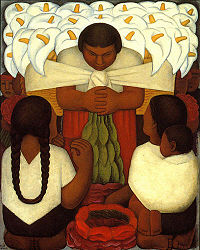Mexican Painting
 From Conservapedia
From Conservapedia Mexican painting has gone through different representative moments with artists whose proposal doesn’t only focus on style and themes, but on leading ideologies that were taken to all aspects of their lives. [1]
Contents
Prehistoric Painting[edit]
It is said that the oldest paint in America was found in caves (rock shelters) of Baja California Sur (6 to 12 thousand years old). Images of men and women, and wildlife are the most common paintings on this Mexican rock-shelters. Land animals depicted include rabbits, mountain sheeps, and deers, as well as marine mammals, fish, and shorebirds. [2]
Pre-Hispanic Era[edit]
Painting is one of the most ancient arts in Mexico.
Aztecs and Mayans, painted on the walls of their temples and tombs. In Mayan culture one may find interesting paintings in Bonampak frescoes. The civilizations of pre-Hispanic Mexico recorded their histories, religious beliefs, and scientific knowledge in books called "codices". [3]
A main function of Aztec Art was to express religious and mythical concepts to legitimize the power of the State. This artistic language spoke predominantly through the form of iconographic symbols and metaphors. For example, the image of the eagle symbolized the warrior and the sun at its zenith. Images of serpents were linked to the gods Tlaloc and Huitzilopochtli, and thus were represented as water or fire serpents, respectively. [4]
Colonial Era[edit]
The Baroque style was developed also in New Spain in its Colonial era; although, it incorporated Indian decorative motifs. Religious paintings intended for churches and portraits of aristocrats were the current subject in this Colonial era. From the XVI to the XVIII Century, Mexican painting played an important didactic role; Because the colonists wanted to make a good impression, some of New Spain's finest artists were hired to paint casta cycles. [5] Miguel Cabrera (1695 - 1768), Cristóbal de Villalpando (ca. 1649 - 1714) and Juan Correa (1646 - 1716) are the best-known painters of New Spain. Baltasar Echave Rioja, Luis Juárez, his son José Juárez and José de Ibarra are also remarkable painters.
Caravaggio, Bartolomé Esteban Murillo and specially Francisco de Zurbarán as Pintor del Rey, had a lasting influence on this Colonial art.


XIX and early XX Century[edit]

Different European Schools during XIX and XX Century, had influence in Mexican painters. Pelegrín Clavé, Santiago Rebull, José Salomé Pina, Juan Cordero, Hermenegildo Bustos, Félix Parra, José Obregón, Leandro Izaguirre, Daniel del Valle, Jose Maria Velasco, Joaquin Clausell and Germán Gedovius (1867–1937) are the main figures in this era.
The two major representative figures of 19th-century Mexican landscape painting, Eugenio Landesio and José María Velasco, met on one of their excursions to the countryside to do outdoor paintings of national landscapes. [6] Joaquín Clausell is Mexico's best known Impressionist painter.


XX Century[edit]
Some of the most important figures in this era are: Rufino Tamayo, Francisco Goitia, Frida Kahlo, Juan O'Gorman, Remedios Varo, Leonora Carrington, Gunther Gerzso, Jose Luis Cuevas, Rafael Coronel and Juan Soriano as well as Mexico’s great muralists Diego Rivera, Jose Clemente Orozco and David Alfaro Siqueiros.
Tamayo painted on an easel and his models were the masters of Modern Art, Picasso, Cezanne, and Braque. His subjects, however abstractly treated, were Mexican to the core. [7]
Gunther Gerzso is best known for his geometric abstractions. In painting, Gerzso moved from Surrealism to Abstract Expressionism.
The painting of Frida Kahlo may be classified as Surrealism or Magic Realism.
Diego Rivera, Flower Day, 1925.
Muralism[edit]
The Mexican Modernist School (and muralists) abandoned the solemn and detached art of Europe and instead embraced bold New World imagery full of color and human activity. [8] Some remarkable painters of this time are: Diego Rivera, David Alfaro Siqueiros, and José Clemente Orozco. Gerardo Murillo (Dr. Atl) is another important painter of this School, but he also painted traditional landscapes and contemporary art experiments.
"Mural en Cerámica II" by Luis Nishizawa.
See also[edit]
- Painting Masterpieces
- Golden Age of Spanish Painting
- Mexican Painters
- Mexican Painting Masterpieces
- Mexico by World Painters
- Mexican Still Life Painting
- Bartolomé Esteban Murillo

External links[edit]
- The Arts in Latin America, 1492–1820
- Casta painting and colonial latin america at the americas society by Yasmin Ramirez.
- Colonial Painting
- Mexican painting Franz Mayer Museum.
- Rufino Tamayo at 91 By Mark A. Uhlig, THE NEW YORK TIMES.
- The Great Mexican Painters
- Museo Soumaya In Spanish.
- Academy of San Carlos
Categories: [Painting] [Mexican Painters]
↧ Download as ZWI file | Last modified: 02/15/2023 20:32:12 | 14 views
☰ Source: https://www.conservapedia.com/Mexican_Painting | License: CC BY-SA 3.0
 ZWI signed:
ZWI signed:


















 KSF
KSF